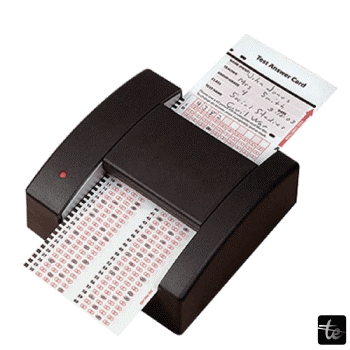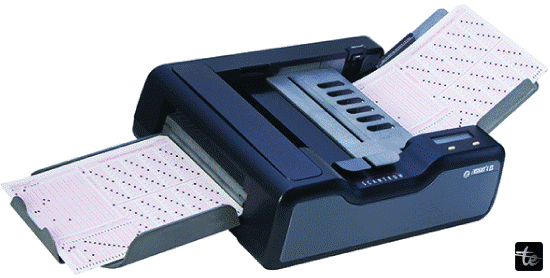OMR in Computer
Introduction
Through Optical Mark Recognition (OMR) technology, a machine can identify marks like ticks, bubbles, and checkmarks created on paper forms. OMR is perfect for high-volume data gathering since it can gather information from paper forms quickly and correctly. OMR technology takes an image of the form with a scanner or camera and then analyses the image to determine the marks. Following mark recognition, data can be automatically moved to a computer system for analysis and processing.

OMR ensures that data is collected regularly and lowers the possibility of human error, making it an extremely accurate data-collecting technique. OMR forms can be made to check for mistakes automatically, like placing several marks in the same field, and to notify the user of any mistakes. OMR is not only very accurate but also very efficient. The technology is perfect for large-scale data collection initiatives since it can quickly capture massive volumes of data. OMR forms can also be self-contained, eliminating the need for human data entry and enabling on-site data collection.
The fact that OMR is a non-intrusive data collection technique is one of its primary advantages. In contrast to other data-gathering techniques, such as online questionnaires or in-person interviews, OMR doesn't need the responder to actively participate. This makes it perfect for usage with hard-to-reach populations, such as youngsters or individuals with disabilities. The affordability of OMR is another advantage. Because OMR forms do not require manual data entry, they are frequently less expensive to generate than conventional forms. Furthermore, by eliminating the need for human error-prone manual data entry, technology can lower the cost of data collection.
History of OMR
OMR's history dates back to the early 1900s. An optical scanner that could read paper with holes punched was granted a patent in 1914. The earliest tabulating machines, which were used to compile and organise records, employed this technology.
- OMR technology started to be used in several packages, including checks, evaluations, and surveys, in the 1950s. In 1957, the first OMR system for sale was introduced. Exams were graded using this device by examining students' annotated answers on specially created answer sheets.
- The OMR era saw growth in the 1960s. A range of human-marked text styles, bubble sheets, scannable forms, and even handwritten text were all examined by new methods.
- The OMR period saw widespread use in various applications in the 1970s. It was employed to grade tests, compile survey data, and even inspect votes.
- Through the 1980s, the OMR period continued to grow. New structures that were more accurate and effective were introduced.
- OMR technology has been employed even more widely since the 1990s. It was utilised in several new applications, including processing scientific data and inventory tracking.
- The OMR period kept evolving in the 2000s. New, easier-to-apply, and more affordable structures had been delivered.
In various industries, optical mark recognition (OMR) has emerged as a vital tool for automating data collection and processing. Data collection, analysis, and utilisation have revolutionised thanks to their applications in education, healthcare, elections, and surveys. OMR technology has become a useful tool for businesses looking to optimise their data management procedures because of its capacity to save time, increase accuracy, and boost productivity.
OMR Software
OMR software is a computer program that enables processing surveys, tests, attendance sheets, checklists, and other plain-paper forms generated on a laser printer using an image scanner on a desktop computer.
Data is extracted from OMR sheets using it. When collecting data, scanning equipment pays close attention to various elements, including the pattern design and the thickness and dimensions of the OMR sheet paper.
Working of OMR Sheet Checker Software

A typical OMR sheet checker programme operates in the manner described below:
- It must be integrated with your current system first and foremost. It would help if you were fully acquainted with the Windows and machine models for this. Select the OMR checking software based on the computer model the program is compatible with, as others aren't.
- Once the software is integrated with the computer, you can begin by examining its settings and instructions, among other things. Although it is generally recommended to use the default settings, you are free to make any further changes that meet your needs.
- The next step is to connect a standard office scanner (Flatbed, ADF, or MFP) to your computer and adjust its settings directly from the software interface.
- You can begin scanning the OMR sheets when the setup is operational. After placing the sheets correctly in the scanners sheet panel, select "scan" or "scan and read" from the software's menu. After receiving the command, the software will begin scanning the sheets.
- Following scanning, the software reads the scanned pages automatically to extract the final data.
- The evaluation and report generation phase is now underway. Based on the collected data, an automatic evaluation is conducted, and comprehensive comparative reports are produced as the end product.
Features of OMR
- Accurate Data Capture: OMR technology guarantees accurate and dependable data collecting by accurately identifying and interpreting marked replies. It can identify user modifications, such as ticked or unchecked boxes, bubbles, or lines, to forms, surveys, or questionnaires.
- Error reduction: By automating the data collection process, OMR lowers the chance of human error. It produces more predictable and consistent results by eliminating the possibility of erroneous data entry or improper answer interpretation.
- Scalability: Because OMR systems are scalable, large volumes of data can be processed using them. They are ideal for lengthy processes such as surveys and exams.
- Economical: Establishing an OMR system may result in financial savings for organizations. Administrative overhead and associated expenses can be minimized by streamlining the data collection procedure and reducing manual labor.
- OMR significantly reduces the time required for data collection and analysis. It saves time and resources by quickly processing large volumes of forms, reducing the need for manual data entry.
- OMR systems give undue weight to the confidentiality and preservation of statistics. They guarantee compliance with statistics privacy regulations and offer protections to protect confidential information.
Applications of OMR
- Education and Assessments: OMR technology has greatly altered how educational institutions administer tests, surveys, and evaluations. OMR sheets are frequently used in multiple-choice exams where students must mark their responses. These sheets are processed by automated OMR scanners, which lessen the workload associated with manual review and produce timely and reliable results.
- Surveys and Feedback Forms: OMR is essential to data collection and market research. OMR scanners are used to process surveys and feedback forms with pre-defined answer alternatives in an effective manner. With the help of this technology, human error is decreased, and manual data entry is no longer necessary, guaranteeing accurate and trustworthy results.
- Voting and Election Systems: OMR has been used in several nations to make elections go more smoothly. OMR technology scans ballots with marked options, improving vote-counting efficiency and precision. Voting systems that use OMR technology are renowned for their effectiveness, security, and transparency.
- Healthcare and Patient Forms: OMR technology is used in the healthcare industry to handle medical surveys, insurance claims, and patient forms. Healthcare workers can devote more time to patient care than administrative work by automating data collection.
Advantages of OMR
- High Accuracy: OMR is a particularly accurate data collection method since it reduces the chance of human error and ensures consistent data recording.
- Versatile: OMR can be used for various documents, such as medical forms, employment applications, election ballots, questionnaires, and assessments.
- Cost-Effective: By removing the need for manual data entry and reducing the likelihood of human error, OMR forms can reduce the cost of data collection. The cost of producing them is typically lower than that of other types.
- Efficiency: OMR allows for rapid data collecting, making it the ideal choice for large-scale data collection initiatives.
Disadvantages of OMR
- Limited Data Types: OMR can only capture annotations made on a form. Other types of data, such as handwritten text, cannot be recorded by it. Large text volumes cannot be grouped because doing so would confuse the findings. When dealing with huge text, data may be lost. The only favourable questions are multiple-choice ones.
- Limited Customization: There aren't many design and customisation options available for OMR forms, so they might not meet everyone's needs.
Conclusion
In summary, Optical Mark Recognition (OMR) is a precise and effective data collection technique that works well for large-scale data collection initiatives. OMR is a low-cost, non-intrusive technique for gathering data that lowers the possibility of human error. OMR technology can help you rapidly and accurately capture the necessary information, whether gathering medical data, running a survey, or counting votes.